

Just press go: designing a self-driving vehicle. Ever since we started the Google self-driving car project, we’ve been working toward the goal of vehicles that can shoulder the entire burden of driving.

Just imagine: You can take a trip downtown at lunchtime without a 20-minute buffer to find parking. Seniors can keep their freedom even if they can’t keep their car keys. And drunk and distracted driving? History. We’re now exploring what fully self-driving vehicles would look like by building some prototypes; they’ll be designed to operate safely and autonomously without requiring human intervention. Google’s self-driving car is really an entertainment system on wheels.
(Google) If there was one takeaway from the video Google released last week of its self-driving cars—besides the fact that, you know, they drive themselves—it’s how boring the typical commute could soon be.
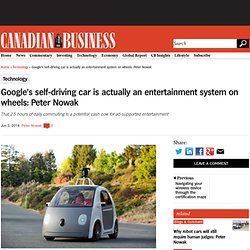
Sure, the people in the video are completely amazed at being chauffeured around by a machine, but of course they would be. It’s a freakin’ robot, after all. But what happens when the novelty wears off? Driverless cars will mean the end of mass car ownership. You should check out my colleague Brad Plumer's excellent list of ways driverless cars like the one Google announced today will make our lives better.
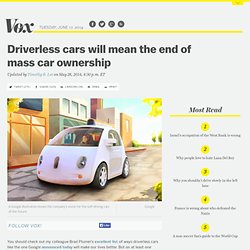
But on at least one dimension, I think he actually understates how much self-driving cars will change our lives. Brad predicts that driverless cars will make car-sharing more popular. I think it'll go much further: virtually eliminating the concept of private car ownership altogether. Instead, almost everyone will get around in driverless taxis. The Design Problems That Google Must Solve in Its Self-Driving Car. Ahoy!
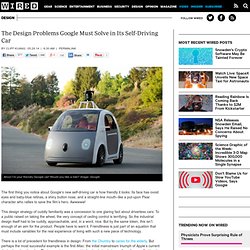
I’m your friendly Google car! Would you like a ride? Image: Google The first thing you notice about Google’s new self-driving car is how friendly it looks: Its face has ovoid eyes and baby-blue retinas, a shiny button nose, and a straight-line mouth–like a put-upon Pixar character who rallies to save the film’s hero. Awwwww! This design strategy of cuddly familiarity was a concession to one glaring fact about driverless cars: To a public raised on taking the wheel, the very concept of ceding control is terrifying. There is a lot of precedent for friendliness in design: From the Chumby to canes for the elderly.
The first iMac. The iMac’s design was meant to teach you to expect almost no friction in set-up, no hurdles to learning how to use such a potentially daunting device. The Google Car does well by that standard: You almost want to hug the thing and protect it from this cruel, cruel world. Autonomy or Control? Google Maps Redesign by Marcel Akiyama. The glass by Abhijeet Wankhade ~ Sokratus. Google Glass - Speedometer App (WIP) by Jack Morgan. Moto 360 Car alarm app by Alex Martinov. Google Car in the wild ;) by Jacques Alomo. Img - Scalawagon of Oz. Europe demands driverless cars be driveable. The latest in a long line of breezy promotional videos from Google has landed.
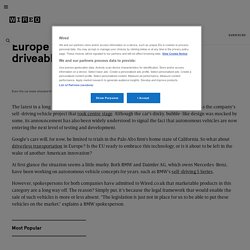
This time, it was the company's self-driving vehicle project that took centre stage. Although the car's dinky, bubble-like design was mocked by some, its announcement has also been widely understood to signal the fact that autonomous vehicles are now entering the next level of testing and development. Google's cars will, for now, be limited to trials in the Palo Alto firm's home state of California. So what about driverless transportation in Europe? Is the EU ready to embrace this technology, or is it about to be left in the wake of another American innovation? At first glance the situation seems a little murky. However, spokespersons for both companies have admitted to Wired.co.uk that marketable products in this category are a long way off. "The legislation is just not in place for us to be able to put these vehicles on the market," explains a BMW spokesperson. Your assignment: Design the interior of the self-driving car.
A place to work -- or work out -- inside your lounge on wheels A place to work -- or work out -- inside your lounge on wheels Driving modeDesigning autonomous vehicles was the focus of this year's Michelin Challenge Design competition.

One finalist entry, led by Kim Do-hyung of South Korea, envisioned a compact Volkswagen city car with a steering wheel that folds away when the car is on autopilot. Passengers can rearrange the interior layout with the aid of electric superconductors. Related Links Related Topics Mark Rechtin Automotive NewsSeptember 23, 2013 - 12:01 am ET For as long as there have been automobiles, vehicle interiors have been designed around the driver. That's a question designers and engineers are pondering as they prepare for the first generation of autonomous and semiautonomous vehicles. "If the driver is no longer driving, then the interior becomes a more democratic space with the other occupants," says Moray Callum, Ford Motor's executive director of Americas design.
Autonomous Concept Vehicle Design. Yesterday, I finished the final corrections of my Master thesis and will take it to be printed today.
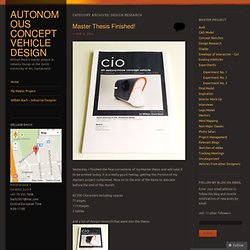
It is a really good feeling, getting this Portion of my masters project completed. Now on to the erst of the items to aleviate before the end of this month. 85’200 Characters including spaces 71 pages 113 images 2 tables. Autonomous Vehicle Design Challenges. If 90% of vehicles on the roads in the US were autonomous, fuel consumption would be reduced by 724 million gallons, 4.2 million accidents could be prevented, and 21,700 lives could be saved, according to a recent report from the Eno Center for Transportation.

With statistics like that it’s no wonder that autonomous vehicle R&D is such a hot field. Nuvation is leading that charge. We joined forces with an autonomous vehicle research team from the University of Waterloo, and we’re already years into adding autonomous capabilities to DiscoFish, our own vehicle design. Legislative issues aside, there are many obstacles to overcome before autonomous vehicles are mainstream. Here is what we’re currently working on: Coordinated Platooning. Platooning is a traffic system where vehicles travel together in a synchronized and densely packed group, communicating with wireless technology.